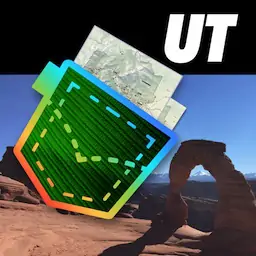IowaNHT Auto Tour Guides |
The Mormon Pioneer National Historic Trail route across Iowa. Published by the National Park Service (NPS).
featured in
covered parks
National Trails System
National Park Service
U.S. Department of the Interior
National Historic Trails
Auto Tour Route Interpretive Guide
The Mormon Pioneer Trail
Across Iowa in 1846
Leaving Nauvoo and “Crossing
the Mississippi on the Ice,” by C. A.
Christensen
Reconstructed Latter-day Saints Temple at Nauvoo,
Illinois.
NATIONAL HISTORIC TRAILS
AUTO TOUR ROUTE INTERPRETIVE
GUIDE
The Mormon Pioneer Trail Across Iowa in 1846
Prepared by
National Park Service
National Trails Intermountain Region
324 South State Street, Suite 200
Salt Lake City, Utah 84111
Telephone: 801-741-1012
www.nps.gov/cali
www.nps.gov/oreg
www.nps.gov/poex
www.nps.gov/mopi
NATIONAL PARK SERVICE
DEPARTMENT OF THE INTERIOR
April 2007
Second Printing September 2010
contents
Introduction. . . . . . . . . . . . . . . . . . . . . . . . . . . . . . . . . . . . . . . . 1
A New Faith . . . . . . . . . . . . . . . . . . . . . . . . . . . . . . . . . . . . . . . . 3
Clash of Cultures . . . . . . . . . . . . . . . . . . . . . . . . . . . . . . . . . . . . 4
Exodus From Nauvoo. . . . . . . . . . . . . . . . . . . . . . . . . . . . . . . . . 7
Winter Retreat Across Iowa. . . . . . . . . . . . . . . . . . . . . . . . . . . 10
Places to Pause, To Rest…To Die. . . . . . . . . . . . . . . . . . . . . . . 11
A Far Reaching Impact. . . . . . . . . . . . . . . . . . . . . . . . . . . . . . . 14
Sites and Points of Interest
Nauvoo, Illinois to Council Bluffs, Iowa . . . . . . . . . . . . . . . . . . . 16
For More Information . . . . . . . . . . . . . . . . . . . . . . . . . . . . . . 34
Credits. . . . . . . . . . . . . . . . . . . . . . . . . . . . . . . . . . . . . . . . . . . 34
Regional Map. . . . . . . . . . . . . . . . . . . . . . . . Inside Back Cover
Auto Tour Route Interpretive Guide
Iowa - Nebraska
Introduction
T
he Mormon Pioneer
National
Historic Trail
follows the route
Auto Tour
established by
Brigham Young
Route
to bring his
followers from Nauvoo, Illinois,
to the Valley of the Great Salt
Lake, where The Church of
Jesus Christ of Latter-day Saints
has been based for more than
160 years. That first migration
of Latter-day Saints to the Great
Basin occurred in two stages: in
1846, from western Illinois to
the Missouri River in the area
of today’s Council Bluffs, Iowa;
and in 1847, from the Missouri
River to Salt Lake City. This Auto
Tour Route interpretive
guide covers the
1846 segment of
Mormon Trail from
Illinois through
Iowa. Because
they have not been
designated by Congress
Auto Tour Route Interpretive Guide
Iowa - Nebraska
as part of the Mormon Pioneer National Historic Trail, routes and
sites used by later Mormon wagon trains and handcart companies are
not included in this guide.
Individual Auto Tour Route interpretive guides such as this one are
in preparation for each state through which the trail passes. As you
follow the guide, watch for Auto Tour Route highway logos marking
the general route of the Mormon Pioneer National Historic Trail.
In addition, a National Park Service brochure with a map of the
entire Mormon Pioneer National Historic Trail is available at many
trail-related venues, and also can be requested from the trail’s
administrative office at 324 South State Street, Suite 200, Salt Lake
City, Utah.
Historic Nauvoo, pioneer wagon ruts, emigrant camps, and other
places of interest along or near the trail corridor are listed within this
guide. Driving directions are also provided. Entrance and parking fees
may be charged at some locations; hours may vary at the discretion
of the managers —you may want to call ahead. Large groups are
encouraged to make prior arrangements for tours, where available.
2
Auto Tour Route Interpretive Guide
Iowa - Nebraska
A New Faith
M
ormons, as Latter-day Saints are popularly called, practice a
unique religion that arose in 1830 from the teachings of church
founder Joseph Smith, Jr. Early converts to the new faith followed
their prophet from New York to Ohio, Missouri, and Illinois through
the 1830s and ’40s. They were driven from each state by threats and
violence.
The reasons for the Latter-day Saints’ early troubles still are debated,
but religious, political, economic, and social practices all were at
issue. Because Mormon beliefs about God and family differed in
important ways from mainstream Christianity, they drew criticism
and scorn. Because the Latter-day Saints created their own separate
towns, religion-based governments, and security forces, their
neighbors became uneasy and fearful. Resentment grew as the
church became involved in local, state, and eventually, national
politics. Disagreements led to legal battles and, in cases, violence and
retribution. Joseph Smith and his followers were repeatedly forced to
move on.
…I intend to lay a foundation that
will revolutionize the whole world.
—Joseph Smith, founder, Church
of Jesus Christ of Latter-day Saints
Why it is, that so many professing
Christianity, and so many professing
to reverence the sacred principles
of our Constitution (which gives
free religious toleration to all),
have slandered and persecuted this
sect of Christians? —Unknown
correspondent, Juliet (Illinois)
Courier, June 1841
3
Auto Tour Route Interpretive Guide
Iowa - Nebraska
Clash of Cultures
I
n 1839, Joseph Smith and his faithful fled Missouri, whose
governor had ordered the Mormons to leave or be exterminated.
They found refuge in Illinois, where an advance group of Latter-day
Saints had prepared a new town site. There, in a horseshoe bend
of the Mississippi River, they built up the settlement of Nauvoo,
meaning “The Beautiful Place,” and began work on a stately
limestone temple.
The Saints impressed their new neighbors with their industry
and order, but goodwill soon was eroded by disputes over money,
livestock, and politics. Nauvoo’s neighbors warily eyed Joseph
Smith’s impressive Nauvoo Legion, a 3,000 to 4,000-man militia that
the Illinois state legislature had authorized Nauvoo to form. (County
militias were common at that time.) Latter-day Saints were accused
of protecting law-breakers and debtors among them; anti-Mormons
were accused of kidnapping citizens of Nauvoo to face charges
elsewhere. Feelings were heated further by doctrinal disagreements
within the church itself, and especially by whispers that some leaders
at Nauvoo were secretly practicing “plural marriage” —polygamy, the
marriage of a man to more than one wife.
4
Auto Tour Route Interpretive Guide
Iowa - Nebraska
Tragic events were set in motion in June 1844 when disaffected
Mormons published a newspaper criticizing Joseph Smith. The
Nauvoo city council, acting under a new libel ordinance, declared
the paper a “public nuisance” and had the Nauvoo Legion destroy
the press. Angry free-speech supporters and anti-Mormons accused
Smith, who was Nauvoo’s mayor, of ordering the destruction,
and demanded his arrest. Authorities charged Joseph Smith with
inciting riot and ordered him to appear in court at the county seat
of Carthage, about 25 miles southeast of Nauvoo. Fearing violence,
Smith briefly fled Nauvoo but went voluntarily to Carthage after the
governor of Illinois guaranteed his protection. Joseph, his brother
Hyrum, and several other high church leaders were jailed there and
placed under the guard of local units of the Illinois State Militia. A
few days later, on June 27, a mob of some 200 men —likely with help
from some hostile militia guards— stormed the Carthage jail and
murdered Joseph and Hyrum Smith.
The brutal shootings shocked the Mormon settlements, leaving both
Latter-day Saints and their non-Mormon neighbors fearing more
bloodshed. Officials on both sides struggled to keep the peace as
rumors flew and fears deepened. During that uneasy time, several
followers of Joseph Smith claimed the right to succeed him as church
leader. Brigham Young, who was a senior church official and a strong
supporter of plural marriage, soon assumed leadership.
It was the most beautiful town site that
I ever saw. The temple was built on the
high ground about the middle of the
town plat and was a perfect building,
built of cut stone… —Hawkins
Taylor, Sheriff, Lee County, Iowa
…[Nearly] all of the old [nonMormon] citizens are anxious to sell
their property, and many of them
I have no doubt will move away.
There is not only in this village, but
all through the country, a strong
disinclination to live near the
Mormons. —Benjamin F. Morris,
American Home Missionary
Society, Warsaw, Illinois, August
21, 1841
5
Auto Tour Route Interpretive Guide
Iowa - Nebraska
Acts of violence sparked now and then over the following year, but
serious hostilities flared again in September 1845 when anti-Mormon
raiders burned about a hundred homes and several farmsteads.
Weary of conflict, Brigham Young promised Illinois state officials that
the Latter-day Saints would leave Nauvoo and their outlying farms
the following spring.
Oh wretched murd’rers, fierce for
human blood! You’ve slain the
Prophets of the living God, Who’ve
borne oppression from their early
youth, To plant on earth the principles
of truth. —Eliza Roxcy Snow, poet
of the Latter-day Saints and plural
wife of Joseph Smith, July 1, 1844
6
Auto Tour Route Interpretive Guide
Iowa - Nebraska
Exodus From Nauvoo
O
ver the winter, the stricken Saints labored to complete their
temple even while preparing to move to some undetermined
place beyond the Rocky Mountains. Mormons gathered money,
maps, and supplies, built sturdy wagons, and organized themselves
into companies of 10, 50, and 100. They planned to begin an orderly,
phased emigration of up to 17,000 church members in the spring, but
rumors of a coming raid prompted Brigham Young to evacuate the
families of key church leaders during the bitter late winter of 1846.
Young hoped the early departure of church authorities would deflect
further attacks on Nauvoo by showing that the Latter-day Saints were
serious about leaving in the spring, as promised.
The first train of Mormon wagons ferried across the Mississippi on
February 4, and then camped for nearly a month at nearby Sugar
Creek while waiting for Young to conclude business at Nauvoo.
During the wait, temperatures dropped further and the river froze.
Some from Nauvoo, afraid of being left behind, took advantage of
the apparent miracle by crossing the ice to join the advance company,
the “Camp of Israel.” Others crossed the river in both directions to
retrieve supplies, visit relatives, and conduct business. By the time
camp was ready to move, the company had grown from Young’s
intended 1,800 to about 2,500 emigrants.
Some 500 wagons in Brigham Young’s Camp of Israel rolled
northwestward out of Sugar Creek Camp on Sunday, March 1, 1846,
heading across southern Iowa Territory toward the Missouri River. If
all went well, they would cross that river by late April, leaving enough
time to reach the Rocky Mountains by fall.
Meanwhile, the main body of Saints prepared to leave the Nauvoo
area in spring, as originally planned. Once the grass was high
enough to feed their livestock, some 10,000 Mormons set out in
small companies to catch up with the Camp of Israel. Theirs was the
second and largest emigration from Nauvoo. Over the summer, a
few hundred of those who had stayed behind left to join dissident
factions of the church. (Several of those groups merged in 1860 to
create the New Organization, later called the Reorganized Church
7
Auto Tour Route Interpretive Guide
Iowa - Nebraska
of Jesus Christ of Latter Day Saints, now named the Community of
Christ. This group, which opposed polygamy but followed other
Mormon teachings, eventually was led by Joseph Smith III, oldest son
of Joseph Smith, Jr. and his widow, Emma.) A few Mormon families
quietly remained in the area and peacefully continued their lives
there.
By early autumn, only about 700 Latter-day Saints remained in oncebustling Nauvoo and nearby Mormon settlements. Many of those left
behind —too poor, too ill, or too infirm to travel— were driven out
by anti-Mormon raiders in September 1846. Some of these refugees
found shelter and work in surrounding communities, while others
camped on the Iowa side of the river, in need of food, transportation,
and medical help. Several died there, outside of Montrose, Iowa, of
hunger, disease, and exposure. Church leaders sent back three rescue
wagon trains to move these people to places where they could spend
the winter safely. Theirs was the third and final Mormon emigration
from Nauvoo.
As they started West, many emigrants looked back across the river
for a last glimpse of Joseph Smith’s shining, white temple. At a public
dedication on May 1, shortly before the main body of Latter-day
Saints left Nauvoo, the people had prayed that the temple would
We all halted & took a farewell view of
our delightful City….We also beheld
the magnificent Temple rearing its
lofty tower towards the heavens…
we also took a farewell look of our
Comfortable homes we had labored
so hard to rear for the Comfort of our
families…my heart did swell within
me. —Newel Knight, Nauvoo, April
24, 1846
8
Great injustice inflicted by a lawless
and irresponsible mob. Can these
things be done in a republic and not
be rebuked by an efficient expression
of public sentiment? —Bloomington
(Illinois) Herald, October 30, 1846
The great body of [Mormons] removed
voluntarily, but a small remnant
of them were barbarously expelled
with force, and in a manner which
reflects but little credit on the state or
its institutions. —Illinois Governor
Thomas Ford, December 7, 1846
Auto Tour Route Interpretive Guide
Iowa - Nebraska
stand as a monument to Joseph Smith. Despite the prayers, an
arson fire destroyed the abandoned structure in 1848 and a tornado
knocked down some of its remaining walls two years later. By then,
the Latter-day Saints would be planning a new temple and building
their greatest tribute to Joseph Smith: a Mormon Zion in the Valley of
the Great Salt Lake, in present-day Utah.
Mormon Trail through Garden Grove Historic Site, Garden Grove,
Iowa.
9
Auto Tour Route Interpretive Guide
Iowa - Nebraska
Winter Retreat Across Iowa
I
n February 1846, the first party of Mormon pioneers faced nearly
300 miles of winter-bare prairie stretching between Nauvoo and
the Missouri River gateway to the Oregon Trail. Those emigrants who
left Nauvoo in a panic were poorly equipped for the trek, and few
carried enough feed for their draft animals. Lacking spring grasses
along the established roads, Young’s company traveled poorer tracks
close to the Missouri border in order to trade with the Missouri
settlements for livestock feed and supplies. Bad weather made travel
more difficult. As rain set in and the ground thawed, narrow wagon
wheels mired axle-deep, bringing wagons to a halt. Families waited
miserably in camp as the men fanned out across the lightly settled
territory to work for food and pay, and trade teams crossed cautiously
into unfriendly Missouri to bring back needed supplies. The Camp
of Israel spent a month crossing the first 100 miles, a distance that
should have taken but 10 days.
The pioneers comforted and helped each other along: those who had
food, bedding, and shelter shared with those who had none; those
with musical or literary talent tried to cheer and inspire the camp.
Their hardships brought the people together, forging their faith,
group identity, and sense of destiny. The spirit of these Mormon
pioneers rings in the lyrics of their now-famous anthem, “Come,
Come, Ye Saints,” written one miserable, muddy night in southcentral Iowa by emigrant William Clayton, in honor of the birth of his
son.
A large portion of our journey in
Iowa seemed to me to be a continuous
mud hole. —Benjamin Critchlow,
autobiographical account of the
1846 Mormon emigration
10
Come, come, ye Saints, no toil nor
labor fear; But with joy wend your
way. Though hard to you this journey
may appear, Grace shall be as your
day....All is well! All is well! —William
Clayton, author of Come, Come,
Ye Saints, April 13, 1846
Auto Tour Route Interpretive Guide
Iowa - Nebraska
Places to Pause, to Rest…to Die
T
wo months on the trail, battling mud and mishaps across half of
Iowa, exhausted the Camp of Israel, depleted its food supplies,
and threatened to unravel Brigham Young’s loose-knit plan to reach
the Rocky Mountains that summer. Many emigrants were too ill or
too poorly equipped to continue west. Church leaders worried, also,
for the thousands of faithful who followed.
The Mormon wagon train stopped far short of the Missouri River
on April 19 to build a temporary way station called Garden Grove.
Almost overnight, the pioneers dug wells, built houses, bridges, and
fences, plowed and planted. Several hundred emigrants settled in to
rest, heal, and prepare for the final push to the Rockies. If their crops
were successful, they would also help feed the later Nauvoo wagon
companies that would soon be arriving. Garden Grove was good
farming country, but it was infested with rattlesnakes. It was not the
entire solution to their problems. The main body of the company
rolled on.
On May 16, a scout selected a beautiful site that he named Mt.
Pisgah, after the hilltop from which Moses looked upon the chosen
land. The Latter-day Saints built more cabins and dugouts there,
and they plowed and planted a thousand acres of prairie. At least
200 emigrants stayed there, and the population grew to about 700
as later arrivals joined them over the summer. Despite the beauty of
its setting and the promise of its name, however, Mt. Pisgah was a
place of sorrow. Several score of people, forced from their homes and
weakened by exposure, exhaustion, and poor nutrition, would die
there over the coming months.
This was a great place for rattlesnakes.
Either an ox or a horse came up
almost every night with a swelled
head, etc. I became very much
dissatisfied with this place, and it
seemed as though I could not tarry
there under any consideration. —Ezra
Benson, autobiographical account,
Garden Grove, Iowa, 1846
[My son] died in my arms about four
o’clock....He died with the hooping
cough & black canker [scurvy]…We
are entirely destitute of any thing even
to eat much less to nourish the sick.
—Hosea Stout, Garden Grove,
Iowa, May 8, 1846
11
Auto Tour Route Interpretive Guide
Iowa - Nebraska
Meanwhile, the bulk of the Camp of Israel moved on once more,
finally reaching the Missouri River Valley on June 14, 1846—too
late for even a “swift company” to start across the Great Plains and
over the mountains. On the Iowa side of the river they established
a “Grand Encampment,” which continued to receive oncoming
emigrants through the summer. By winter, some 2,500 Mormons
would be settled into make-do shelters along the east bank of
the Missouri River. Thousands more fanned out from the Grand
Encampment, ultimately establishing over 90 cluster settlements
within a 40-mile radius of Council Bluffs.
In return for sending 500 men (the Mormon Battalion) to serve in the
recently declared U.S. war against Mexico, Brigham Young received
permission from the federal government to camp on Indian lands
west of the river, as well. Many Mormons crossed over to Nebraska,
built more temporary towns, and settled in for the winter “on the
edge of the wilderness.” By December, the largest community,
called Winter Quarters, consisted of about 540 cabins, dugouts, and
shanties, home to nearly 4,000 people.
“Kanesville” Mormon settlement on the banks of the Missouri River (presentday Council Bluffs). Courtesty of the Utah State Historical Society.
12
Auto Tour Route Interpretive Guide
Iowa - Nebraska
At Mt. Pisgah, Garden Grove, Winter Quarters, the Grand
Encampment, and other Mormon settlements, hundreds of emigrant
men, women, and children died that sad winter. All told, more
than 700 perished of exposure, malnutrition, scurvy, tuberculosis,
pneumonia, malaria, and other diseases during the winter and spring
of 1846-47.
The Latter-day Saints’ hope for a new Zion might have died there,
as well —but it did not. Under Brigham Young’s encouragement and
leadership, the survivors soon would pick up their feet and begin the
second half of their journey to the Valley of the Great Salt Lake.
The shaking ague fastened deathless
fangs upon me…I shook till it
appeared my very bones were
pulverized. I wept, I prayed, I
besought the Lord to have mercy on
me. —Louisa Barnes Pratt, Cold
Springs encampment near Winter
Quarters, 1846
Scarcely a family escaped sickness and
very few where death did not make an
inroad. A general spirit of lamentation
and sorrow pervaded Pisgah.
—Lorenzo Snow, Mt. Pisgah, Iowa,
1846
“Winter Quarters” on the banks of the Missouri River, by C.A. Christensen.
Courtesy of the Brigham Young University Museum of Art.
13
Auto Tour Route Interpretive Guide
Iowa - Nebraska
A far-reaching impact
B
righam Young and many of his followers left their Missouri River
prairie settlements for the arid expanses of the Great Basin in the
spring of 1847. There, the Latter-day Saints hoped, they would be
out of the reach of old enemies. Young and a small advance party of
emigrants and scouts arrived in the Valley of the Great Salt Lake in
late July 1847. The main body of Nauvoo emigrants, including many
who had wintered at Garden Grove and Mt. Pisgah, soon followed
their trail into the valley to begin new lives in an unfamiliar land of
desert, mountains, and salt flats.
The historic “Gathering to Zion” that began in 1846 continued via
Brigham Young’s original route and other trails, from many points
of departure and by various means —including handcart brigades—
until the transcontinental railroad was completed in 1869. Altogether,
the Mormon wagon trains and handcart brigades were the greatest
organized movement of people across the American West in the
entire emigration era—an emigration based on the deeply held
American principle of freedom of religion. Non-Mormon emigrants
traveling to California and Oregon also used the roads, bridges,
ferries, settlements, and trading posts established by the Mormons on
And at [Mt.Pisgah] we had many
testimonies that the Lord had
not forsaken us, and that He was
mindful of His people who put
their trust in Him. —Sarah Rich,
autobiographical account of 1846
emigration
There was great want of bread in
camp, so that we were oppressed on
every hand, but we cried to the Lord,
who heard our prayers, and we were
fed by his all-bountiful hands…
—Allen Stout, Garden Grove,
Iowa, April 3, 1846
14
There are times and places in the life
of every nation when great spiritual
heights are reached, when courage
becomes a living thing, when faith in
God stands as the granite mountain
wall — firm and immovable— while
hardships, want, hunger, sickness,
sorrow, and death beat down to crush.
Winter Quarters was such a time and
place for the Mormon people.
— Heber J. Grant, President,
Church of Jesus Christ of Latterday Saints, September 20, 1936
Auto Tour Route Interpretive Guide
Iowa - Nebraska
their way to Utah. Under church direction, Latter-day Saints settled
throughout the Southwest and Intermountain West. The journals,
letters, sketches, and photographs they created to document their
experiences across that vast region remain invaluable to historians.
Their stories continue to inspire and fascinate. Today, Latter-day
Saints are mainstream Americans, recognized participants in national
politics, international economies, and the global community.
Clearly, the Mormon exodus to Utah was not a mere footnote in the
history of the American West. It is an integral part of the American
story.
15
Auto Tour Route Interpretive Guide
Iowa - Nebraska
Sites and Points of Interest
Nauvoo, Illinois to Council Bluffs, Iowa
The Mormon Pioneer National Historic Trail begins at Nauvoo,
Illinois, and ends at Salt Lake City, Utah. This guide follows only the
route taken across Iowa by the 1846 Nauvoo emigrant company led
by Brigham Young. Routes and sites used by later Mormon wagon
trains and handcart companies are not included in this guide because
they are not at present congressionally authorized as part of the
Mormon Pioneer National Historic Trail.
Begin this segment of your trip at Nauvoo, Illinois, and follow the
trail west toward Council Bluffs, Iowa. The driving directions below,
along with Auto Tour Route signs along the major highways, will
help you along the route.
Please respect private property by staying in public areas, and help
protect our national heritage by leaving all historic sites undisturbed.
16
Auto Tour Route Interpretive Guide
Iowa - Nebraska
1. Nauvoo National Historic
Landmark (Nauvoo, Illinois)
is the historic town site of
old Nauvoo, established in
1839 by followers of Joseph
Smith. The Nauvoo Temple,
destroyed shortly after the
Mormon exodus, was rebuilt
on-site and re-dedicated in
2002. The temple is not open to
Farmstead exhibit at Old Nauvoo.
the public, but tours of the historic
district, with 25 historic homes, businesses, visitor centers, and
demonstration sites, are available free to all visitors.
Attractions at the Joseph Smith Historic Site (operated by Community
of Christ Church) include the Joseph Smith Homestead and Mansion
House, a reconstruction of his Red Brick Store, and the Smith
Family Cemetery, where Joseph and many of his family members are
buried. Tours start at the Joseph Smith Historic Site Visitor Center;
orientation and exhibits are available there, as well. Closed Sundays;
hours vary by season. For more information go to www.cofchrist.
org/js or call 217-453-2246. Admission to the Visitor Center, site
orientation video, museum exhibits and Red Brick Store is free. There
is a modest fee for the guided tour of the Smith homes.
The LDS Nauvoo Visitor Center (operated by The Church of Jesus
Christ of Latter-day Saints) offers site orientation and historical
information, theatrical performances, and exhibits. For Center
visiting hours go to www.ldschurch.org/placestovisit and search
“Navoo.” Other Navoo attractions include the Brigham Young Home,
the reconstructed Nauvoo Temple, the Trail of Hope interpretive
walk, a 3-hour handcart trek, plays and musical programs, ox-drawn
wagon rides, carriage rides, and horse-drawn wagon tours of historic
Nauvoo. All except the temple interior are open to the general public.
Some activities require reservations, but all are free. Historic sites are
open year-round, but some activities are available only seasonally.
Visit www.ldschurch.org/placestovisit, or call 217-453-2237 for events
schedule and information.
17
Auto Tour Route Interpretive Guide
Iowa - Nebraska
Location: Nauvoo, Illinois, is the trailhead of the Mormon
Pioneer National Historic Trail. It is located on the east bank of
the Mississippi River, across from the southeastern-most corner
of Iowa. To arrive at the main historic district, follow IL-96/
Mullholland Street west through the town’s business district
and past the temple. Where the paved highway makes a sharp
bend to the left, leave the pavement and continue straight on
the gravel street toward the river, then turn left on Main Street.
Maps to specific historic attractions are available at local guest
establishments and church-operated visitor centers.
2. Nauvoo Landing (Nauvoo,
Illinois), at the foot of Parley
Street on the riverfront, is one
of the eastern departure points
from Nauvoo where emigrants
lined up their wagons to be
ferried across the Mississippi
River in February 1846. Later
that month, during several
days of freezing weather, a few
Nauvoo Landing.
hundred people drove their wagons
across the ice from this location. Nearby is a memorial naming those
who died on the Mormon Trail.
Directions: Take IL-96/Mullholland Street west toward the river,
through the town’s business district. Follow the paved highway
where it makes a sharp turn to the left (south) and becomes Park
Street. Continue south on Park Street for 6 blocks to Parley Street.
Turn right and drive to the riverfront.
3. Nauvoo State Park and
Museum (Nauvoo, Illinois)
is the location of Nauvoo’s
first vineyard, which began
producing grapes in the mid1800s. The park features a
1840s-era Mormon house with
museum exhibits, wine cellar,
and press room, a 13-acre lake,
18
Nauvoo State Park & Museum.
Auto Tour Route Interpretive Guide
Iowa - Nebraska
camping, hiking, fishing, and other outdoor activities. Open yearround, free.
Directions: Take IL-96/Mullholland Street west toward the
river and through the town’s business district. Follow the paved
highway where it makes a sharp turn to the left (south) and
becomes Park Street. Follow Park Street for 4 blocks and turn
left onto a gravel road leading into the park, then continue for
approximately 0.15 mile to the vineyard and museum on the right
side of the road.
4. Carthage Jail & Visitor
Center (307 Walnut St.,
Carthage, Illinois). Joseph
Smith and his brother Hyrum
lost their lives here on June
27, 1844. The jail and visitor
center are open year-round;
no admission is charged. For
visiting hours, go to www.
ldschurch.org/placestovisit and
Carthage Jail.
search “Navoo, “ or call 217-3572989. Free guided tours available.
Directions: From Nauvoo, take IL-96/Park Street south along
the Mississippi River for approximately 10 miles to Hamilton.
Turn left (east) onto U.S.-136 and continue another 12 miles
to Carthage. Turn right on North Fayette Street and follow
directional signs to the jail at the corner of Walnut and North
Fayette.
5. Linger Longer Park
(Montrose, Iowa). A pavilion
with Mormon Trail exhibits
commemorates the destitute
Mormon refugees who
subsisted in that area after
being driven from Nauvoo in
September 1846. The park also
offers a panoramic view of
Linger Longer Pioneer Trail Memorial
at Riverfront Park.
19
Auto Tour Route Interpretive Guide
Iowa - Nebraska
Nauvoo, across the river. Open dawn to dusk.
Directions: From Nauvoo, follow IL-96 east then north 9 miles
to Niota. Turn left onto IL-9, a toll bridge (no fare when crossing
west to east, modest fare when crossing east to west) over the
river. Mid-river, IL-9 becomes IA-2. Enter Fort Madison and turn
left onto U.S.-61, paralleling the railroad, and continue for 1.8
miles. Where U.S.-61 intersects with IA-103, jog left (south) and
several blocks later jog right (west) to stay on U.S.-61. Continue
on U.S.-61 for 10.4 miles. Upon passing 289th Street to the left,
slow and watch for a left turn onto Mississippi River Road, which
parallels the river. Turn left there, then immediately turn left into
Linger Longer Park. Trail exhibits are in the pavilion and at the
opposite end of the park.
6. Riverfront Park (Chestnut
Street, Montrose, Iowa) is
the location of old Fort Des
Moines, and the place where
Mormons initially settled in
Iowa while creating Nauvoo
across the river. Because the
fort had been abandoned
before Brigham Young and
others arrived in early 1839,
Riverfront Park at Montrose.
numerous families, including that
of Young, temporarily took shelter in the vacant barracks. Here,
Joseph Smith performed faith healing and predicted that his Latterday Saints one day would gather in the Rocky Mountains. Here, too,
Smith hid from hostile anti-Mormons shortly before his arrest and
murder. At the river’s edge is Montrose Landing, where Mormon
emigrants came to shore after leaving Nauvoo in 1846. Open dawn to
dusk.
Directions: From Linger Longer Park, continue south on
Mississippi River Road, paralleling the river, and follow it into
Montrose. The road becomes First Street. Turn left on Chestnut
Street, cross the railroad tracks, and enter Riverfron













